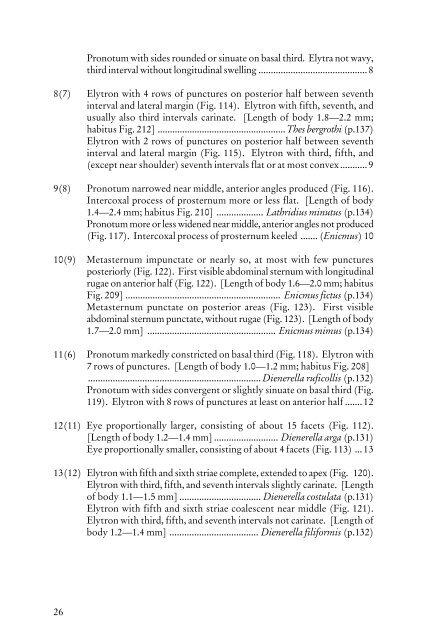Beetles Identification Guide
Beetles Identification Guide
Beetles Identification Guide
You also want an ePaper? Increase the reach of your titles
YUMPU automatically turns print PDFs into web optimized ePapers that Google loves.
26<br />
Pronotum with sides rounded or sinuate on basal third. Elytra not wavy,<br />
third interval without longitudinal swelling ............................................8<br />
8(7) Elytron with 4 rows of punctures on posterior half between seventh<br />
interval and lateral margin (Fig. 114). Elytron with fifth, seventh, and<br />
usually also third intervals carinate. [Length of body 1.8—2.2 mm;<br />
habitus Fig. 212] .................................................... Thes bergrothi (p.137)<br />
Elytron with 2 rows of punctures on posterior half between seventh<br />
interval and lateral margin (Fig. 115). Elytron with third, fifth, and<br />
(except near shoulder) seventh intervals flat or at most convex ...........9<br />
9(8) Pronotum narrowed near middle, anterior angles produced (Fig. 116).<br />
Intercoxal process of prosternum more or less flat. [Length of body<br />
1.4—2.4 mm; habitus Fig. 210] ................... Lathridius minutus (p.134)<br />
Pronotum more or less widened near middle, anterior angles not produced<br />
(Fig. 117). Intercoxal process of prosternum keeled ....... (Enicmus) 10<br />
10(9) Metasternum impunctate or nearly so, at most with few punctures<br />
posteriorly (Fig. 122). First visible abdominal sternum with longitudinal<br />
rugae on anterior half (Fig. 122). [Length of body 1.6—2.0 mm; habitus<br />
Fig. 209] ............................................................... Enicmus fictus (p.134)<br />
Metasternum punctate on posterior areas (Fig. 123). First visible<br />
abdominal sternum punctate, without rugae (Fig. 123). [Length of body<br />
1.7—2.0 mm] .................................................... Enicmus mimus (p.134)<br />
11(6) Pronotum markedly constricted on basal third (Fig. 118). Elytron with<br />
7 rows of punctures. [Length of body 1.0—1.2 mm; habitus Fig. 208]<br />
...................................................................... Dienerella ruficollis (p.132)<br />
Pronotum with sides convergent or slightly sinuate on basal third (Fig.<br />
119). Elytron with 8 rows of punctures at least on anterior half .......12<br />
12(11) Eye proportionally larger, consisting of about 15 facets (Fig. 112).<br />
[Length of body 1.2—1.4 mm] .......................... Dienerella arga (p.131)<br />
Eye proportionally smaller, consisting of about 4 facets (Fig. 113) ...13<br />
13(12) Elytron with fifth and sixth striae complete, extended to apex (Fig. 120).<br />
Elytron with third, fifth, and seventh intervals slightly carinate. [Length<br />
of body 1.1—1.5 mm] ................................. Dienerella costulata (p.131)<br />
Elytron with fifth and sixth striae coalescent near middle (Fig. 121).<br />
Elytron with third, fifth, and seventh intervals not carinate. [Length of<br />
body 1.2—1.4 mm] .................................... Dienerella filiformis (p.132)
















